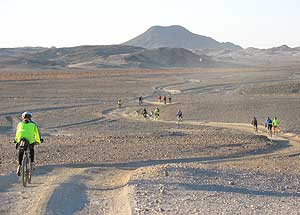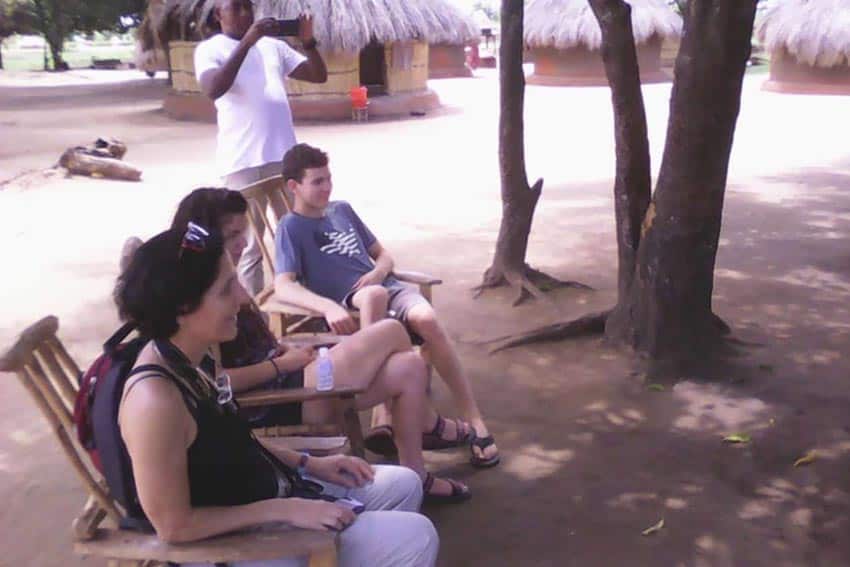
A Trip to the Unknown in Sudan

By Andrea Kaucká and René Bauer
Dry bushes and burnt grass decorate the massive baobab trees. The soil is dusty, here and there goats, cattle or camels are grazing. On a bad track, which is quite deteriorated, full of potholes and dried mud as a leftover of the last rainy season, we make our way into the unknown.
We are in Sudan – a country which doesn’t necessarily belong to the top tourist destinations and, upon hearing its name, often evoques a feeling of fear and discomfort. There is a saying: “Forbidden fruit tastes best” – which applied in this case as well.
When we prepared our overland trip across Africa, we also knew that we would want to have a look at this country of poverty, evil, war and fanatism. And our first meeting with Sudanese people actually made us looking forward to it!
The Unknown
After a long, bone-shaking, rough way we arrive at the center of the Nuba Mountains. Our destination is Kadugli – the capital of the province of South Kordofan in the Nuba Mountains. This mountain range forms the natural border between the Arabic North and the tribal South of Sudan and is inhabited by countless tribes and subtribes.
According to the Islamic calendar it is Monday, 29th Muharram 1436. Arriving in Kadugli feels somehow strange, or at least our feeling is, the more people we see. We are a bit nervous, expecting the unexpected and still feeling slightly anxious.

Kadugli has a relatively clean feel to it, its main roads are asphalted, the dusty side roads are full of people. Women are dressed in their traditional, colorful robes called “tobe,” which is basically a very long, rectangular piece of textile which is wound around the body and over the head.
Very much to our surprise they are not covered in black dresses and headscarves covering everything but the eyes. Women here mingle freely with men, who are wearing either a traditional “jellabiya” or quite elegant European trousers and shirts.
We can see a lot of people chatting with each other, all in all making quite a relaxed, peaceful impression.
The usual meeting place for a Sudanese is the “coffee lady,” which is a woman with a charcoal stove and a little stall full of spices, herbs, teas and coffee. Around her there are plastic chairs spread out. This is where the locals meet up any time of the day.

It doesn’t take long before our car and we are being noticed — a few skeptical glances at first, soon turning into smiles and hand-waving. Our anxiety slowly diminishes, leaving in us only a feeling of eager expectation… How is it here? How are the people?
With Jabir among gothiyas
“Welcoe to the Nuba Mountains!” We are greeted by a handsome young man and hís friendly smile uncovers his immaculate white teeth. For the next few days Jabir would act as our guide and translator.
He shows us around in all those little villages with those thatched roof rondavels, called “gothiya,” goats running around in between and curious small children following us – the older ones are in school.
The villagers are very welcoming and friendly. Jabir explains that women live in those huts with their children, their husbands and grown up children have their own huts.
It is winter in Sudan now, so the landscape is dry, dusty, the hot sun pushes the thermometer to around 45 centigrade (113° F) in the shade. Many villagers sit in the shade of a big tree, sip coffee or tea and discuss local issues.
Grilled Locusts for a Welcome

The hot air is fragrant with odors of coffee, grilled specialties and various herbs. The center of this is the local market. We follow Jabir through the maze of little lanes, stalls and shops.
The market is full of people, many local tribeswomen sit on their blankets or stones and offer their fresh local produce: goat’s or cow’s milk, homemade oil, butter, fruit and veg, grilled Nile perch, Sudanese falafels called “tameeiya,” Arabic gu, hand wrought metal products and in between big piles of Sudanese chips.
“Try those,” Jabir says, “they are delicious and healthy.” He starts smiling. Well, grilled locusts may not look the most appealing thing to eat, but really taste just like normal chips. The woman selling them gives us an enthusiastic thumbs-up and smiles.
A few stalls further down this lane we are offered a piece of “haluk” – a yam which is boiled and peeled. Legends say that, if one eats “haluk”, one will not leave Sudan. We are beginning to wonder if that is applicable to us as well!

Hadjaralmak – the oldest village
We leave the market and Jabir brings us to the oldest village – Hadjaralmak, inhabited by the old tribe called “Kadugli” or “Kodogole.” It is this very tribe after which South Kordofan’s capital was named.
Here we meet their chief Mohammed Rahal Mohammed Rahal (yes, he has his name twice!) who is very pleased to welcome us to his village. We sit down in the shade of a big fig tree and listen to his story.
He tells us that the first white people to arrive in the Nuba area were Turkish, looking for gold. With them they were bringing North Sudanese tribes, which later settled down in this area and mixed with the local tribes. On their arrival, those Northern tribes brought the Islamic religion, which they spread.
Until the 1980’s there were actually tourists coming into the Nuba Mountains, but this came to an abrupt halt when the civil war started in 1983. Nowadays, every visitor from another continent is special to the locals.

“I would like to invite you for tomorrow’s lunch, which is a celebration of my pilgrimage to Mecca. We would feel very honoured to have you here,” chief Rahal says with an inviting gesture.
Lunch and Celebrations
In the morning we wake up to the sound of someone slapping a stick onto a metal drum. It’s this young boy with his donkey again, pulling behind him a tank full of fresh drinking water, which he offers to the houses in town. And by that, he wakes up those who still sleep.
Sudanese people start their day early with a cup of tea. Breakfast consists of beans (“foul sudani”), tameeya, grilled liver, kissra and salad, which is quite a rich breakfast. It is called “fatuur” and is usually eaten around 10 o’clock. Lunch is then later in the afternoon.
Around 3 o’clock we arrive in Hadjaralmak. The big place in the middle of the village has been transformed into a big “dining room” with lots of plastic tables and chairs. The chief welcomes us and together with him we sit around one of those tables, next to us other men with white jellabiyas and turbans.

Before lunch is served, the women, who do not sit with us, hand out drinks, mainly karkadah, which is made from hibiscus flowers, or tabaldi, a juice made from the insides of the baobab fruit-pods. Then someone goes around the tables with a jug of water – for us to wash our hands.
Already we can see the women and children arriving with huge aluminium plates, on them local delicacies, their fragrance making our mouths water! We eat without cutlery, only the right hand is permitted, as we are among muslims and for them the left hand is the hand of the devil.
So we try hard to tear a few pieces off the grilled beef which we then dunk into some kind of gravy and into a very hot chilli sauce called “shata.”
We take pieces of this big, round sorghum bread and dip it into a very sticky okra sauce (okra is the fruit of the hibiscus plant). Besides “aseeda,” a greyish sorghum porridge and fata, a kind of soup with bread in it, kissra and okra are special foods of this area. Meat is mainly served on special occasions.

When an animal is slaughtered, everything is used, all innards and intestines. This lunch is our first experience eating with our bare hands – and this under the watchful eyes of the tribespeople. It wasn’t too hard, though!
Our eyes often meet the other guests’ who don’t hide their pleasure or curiosity at our presence. After lunch, as is custom, we are served strong black tea or coffee, called jebennah, which is spiced coffee drunk from small cups.
Kambala – Dance of Brave Men
As with every celebration, one thing is still missing –- the spiritual and traditional dance — the “Kambala.” Young men dance it, dressed in a long grass skirt, decorated with lots of beads and cows’ horns on their heads. Around their ankles they wear tin rattles made from old tin cans and most of them carry sticks with hair from a horse mane in their hands.

The Kambala is not only just a dance; it teaches young men to behave, as it talks about strength, bravery and respect – just like a bull! Originally, the dance comes from a small village called Sabori, where it was a ritual dance for welcoming young boys into adulthood.
Nowadays, Kambala is a dance for all sorts of occasions –- weddings, funerals, ceremonies, “thanksgiving” and many more. The group of men just in front of us is dancing, stomping their feet to the rhythm of a group of singing women, all the other villagers stand around in a circle, watching and moving their bodies to the rhythm of this old dance.
Although this time, some people, especially the kids, seem a bit more distracted by us, many women look at Andrea’s new henna and smile. The sun is going down and soon after the Kambala finishes, people make their way to their huts, but not without bidding us farewell, many faces radiating a pleasure to see us there…
Travel in Sudan Wild Junket
- Arctic Winter Adventures in Sweden and Norway - January 10, 2021
- Kissed By an Elephant in Zimbabwe - November 22, 2020
- Sudan: Searching Bir Nurayet’s Treasures - November 13, 2019



